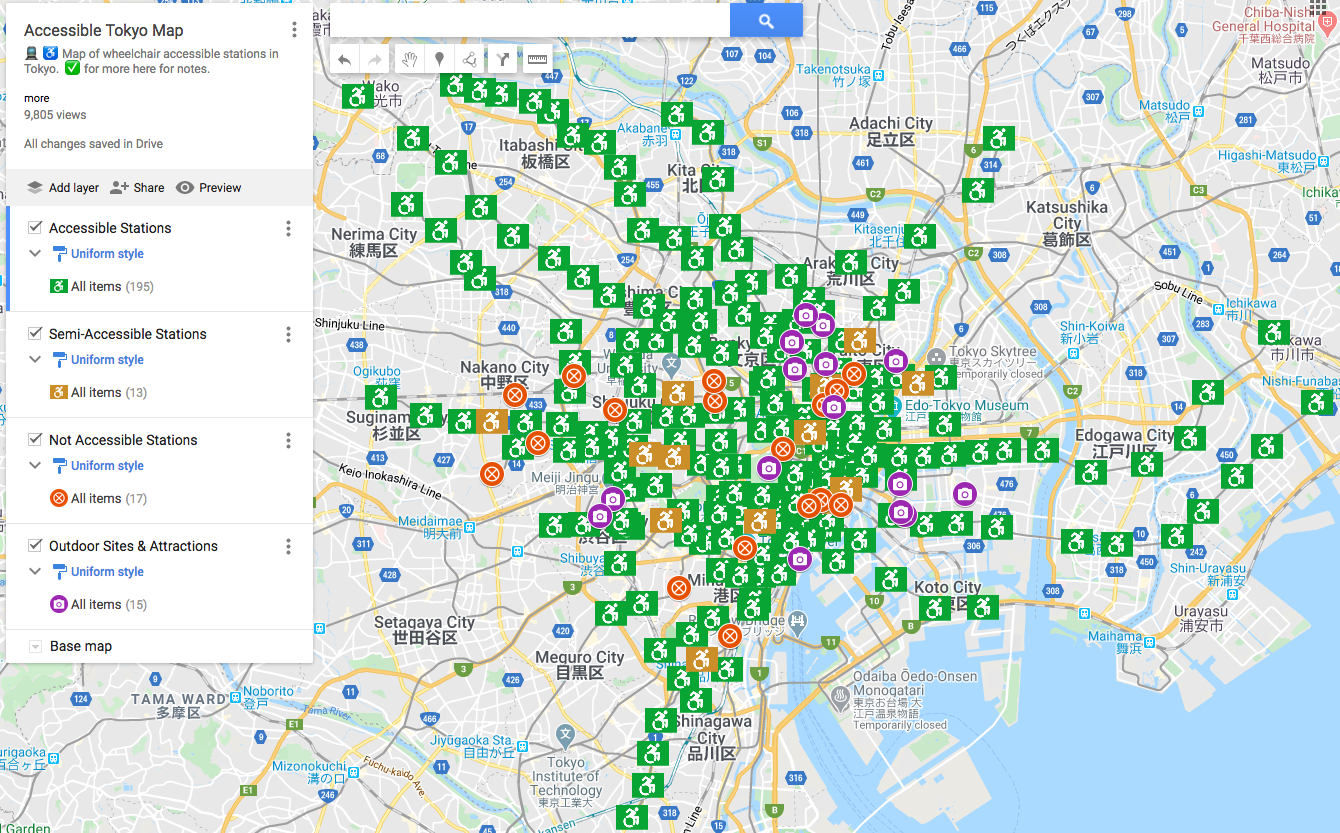Accessible Tokyo
This is an archived post from April, 2016. It is no longer actively maintained.
General Things
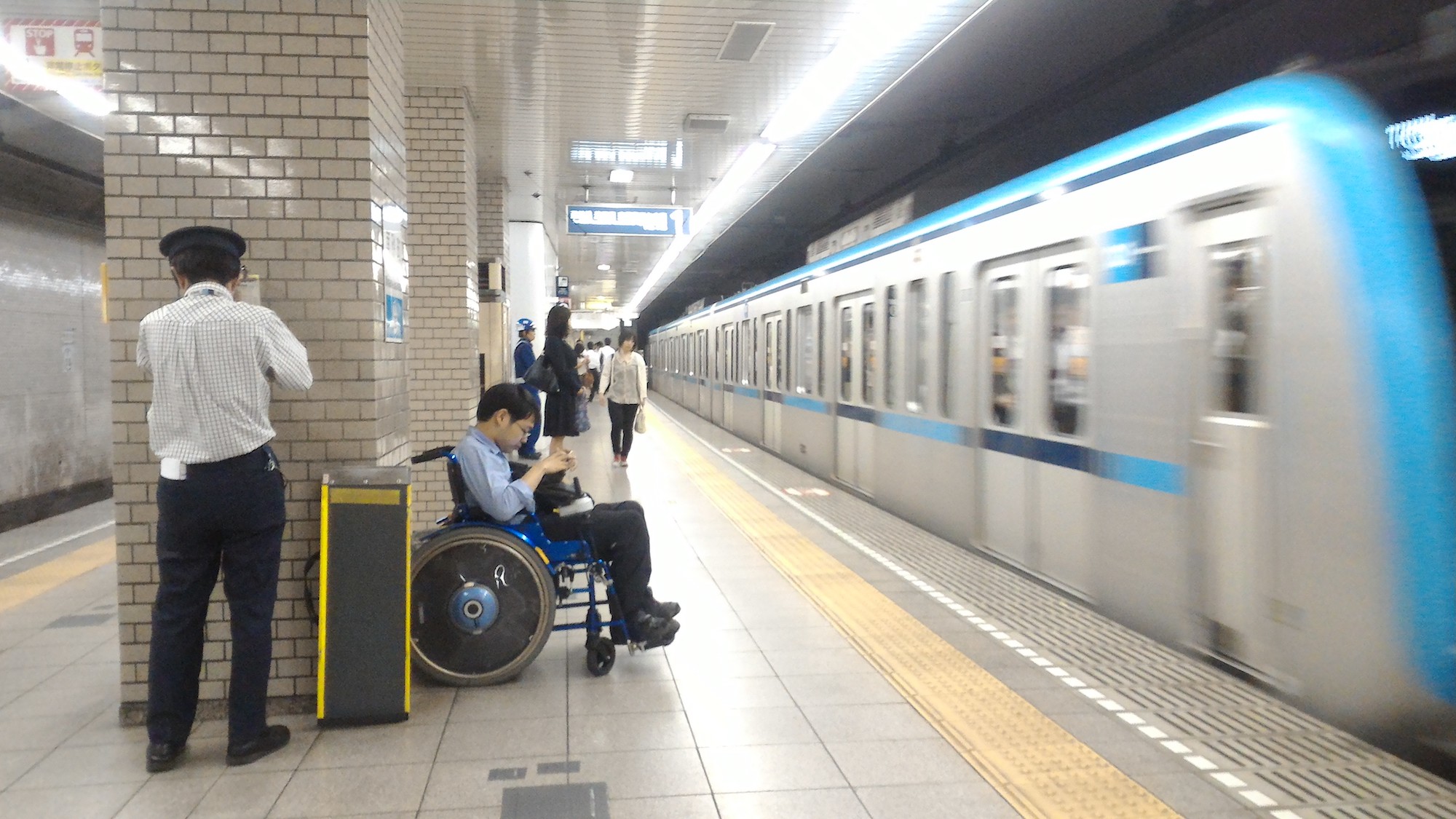 A station attendant waits with a passenger to help him get on the train in Tokyo.
A station attendant waits with a passenger to help him get on the train in Tokyo.
Tokyo’s an incredible, and potentially overwhelming, city that should be experienced first hand. As officially the most populous city in the world, it is incredibly complex. It has over 225 stations in its 23 Wards and over a million people in transit every day. Still, the city is more accessible than it seems. Stations often have washrooms and lifts, and so do department stores and buildings. The information is a bit scattered, but out there!
This guide is designed to provide general information on accommodation, getting around, and some accessible sightseeing locations specifically in Tokyo. It also includes some basic phrases for you to ask for help. Any errors are my own, and please let me know if you have any tips!
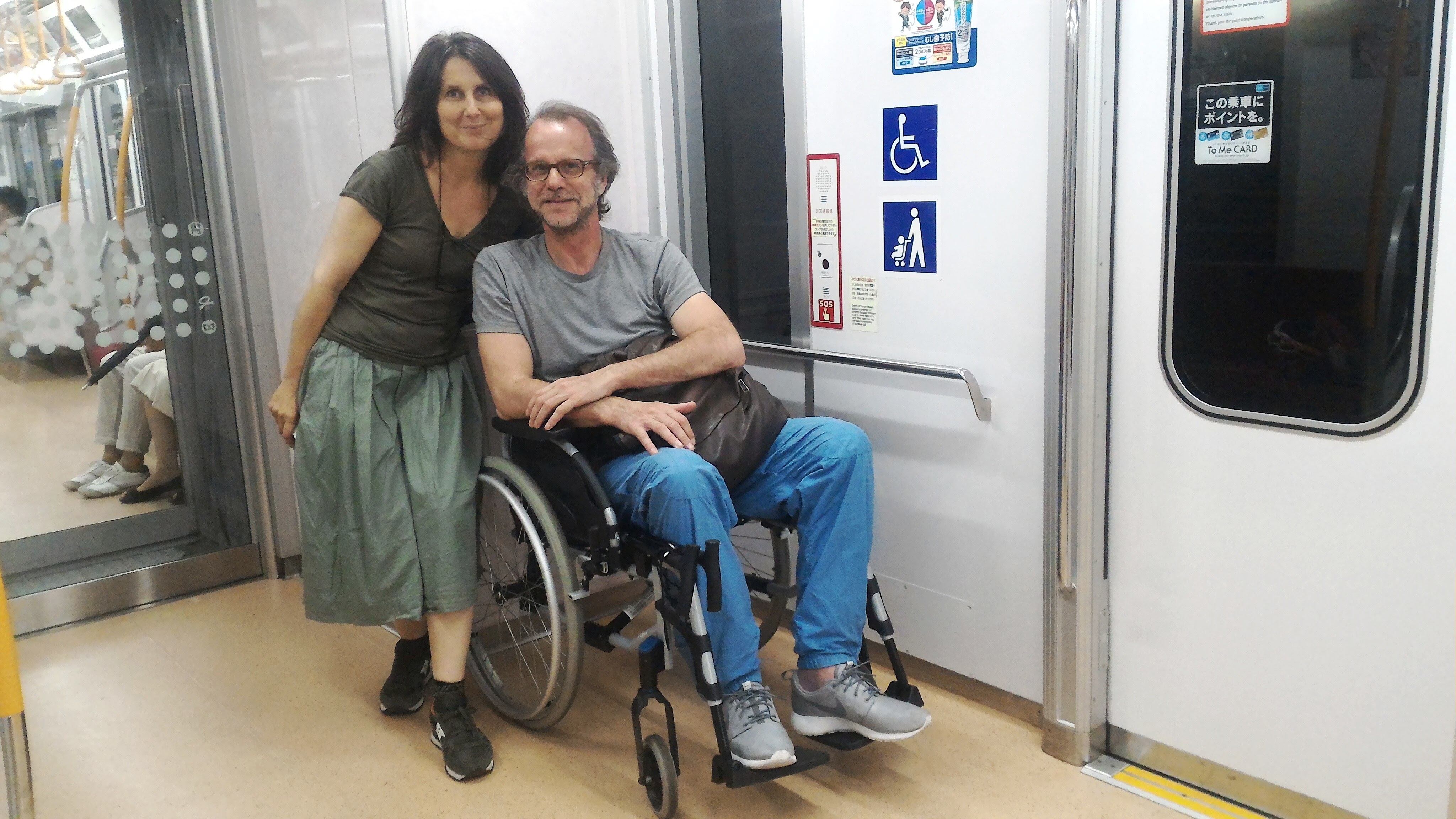 *Met this French couple on the train to Asakusa!**
*Met this French couple on the train to Asakusa!**
People in Japan are often polite and helpful. However, many also do not speak much English. If you can explain what you need, they often go out of their way to help you. If you have a smartphone, it’s best to bring a translation app such as Jsho for Android or Yomiwa for the iPhone.
All assistance counters and reception people are there to support guests. They’re your easiest go to for help. In addition, store staff are also there to help.
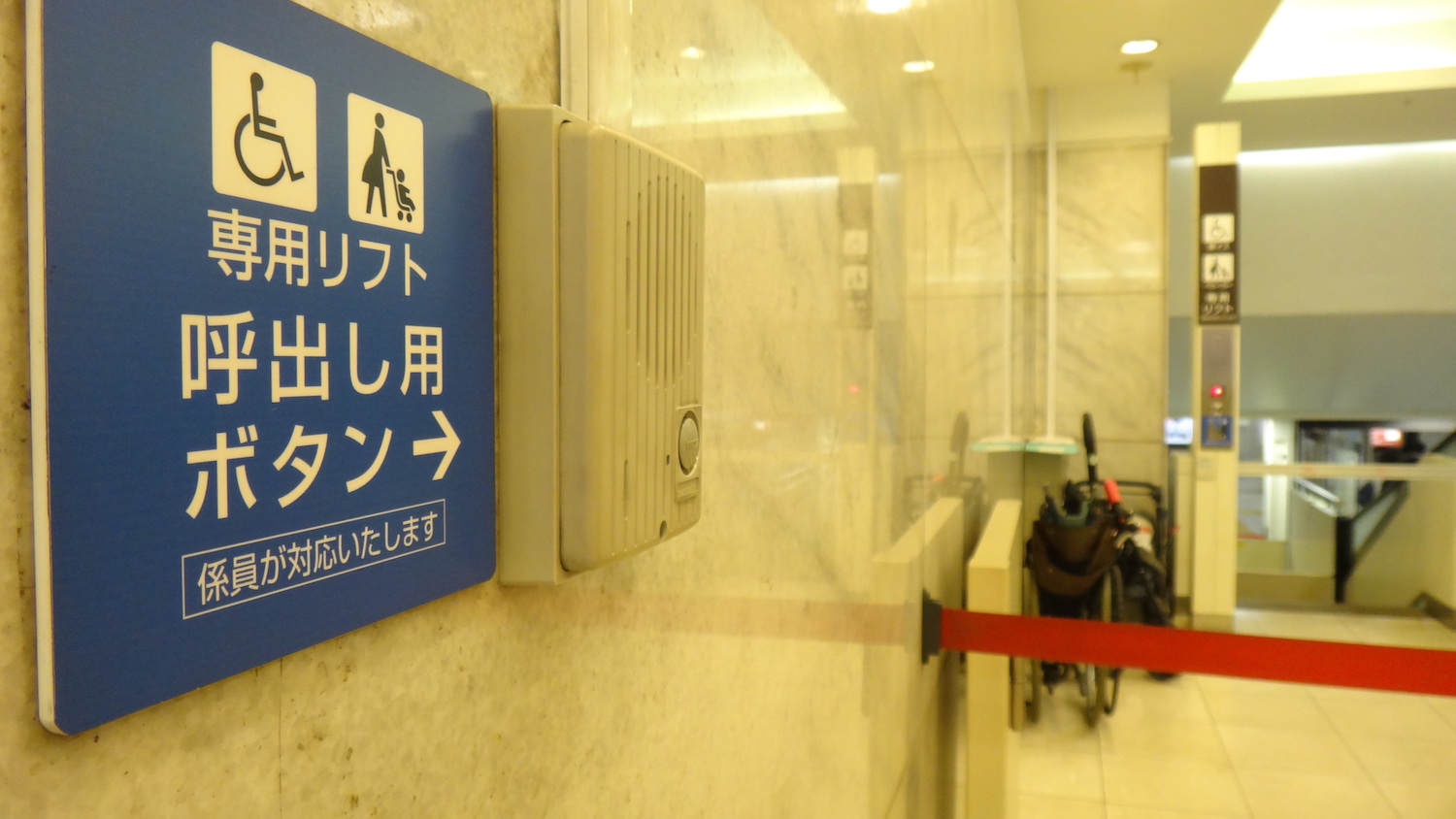 A bell to ask for assistance from Takashimaya Department Store to Nihonbashi Station
A bell to ask for assistance from Takashimaya Department Store to Nihonbashi Station
Accommodation
While most hotels are accessible at the entrance, the major problem for hotels in Tokyo is having accessible washrooms (i.e. with roll-in showers). Many hotels may not, but the bigger barrier is usually language. When contacting potential hotels
The other option now is to use AirBnB, and select ‘Wheelchair Accessible’ in the filters. I’d also suggest you choose a host that has good reviews for responsive service and lives in Tokyo.
As a tip, if you are travelling in Japan and e-mailing or phoning you can use the questions below:
Where is the accessible toilet? 多機能トイレはどこですか? taiki-toire wa doko desu ka?
Does the room have a wheelchair-accessible shower?* 部屋は車椅子ようシャワールームがありますか? *heiya wa kuruma-isu you shyawaa room ga arimasu ka?
Responses:
There is.* 有る/有ります/ある Aru / arimasu *
There isn’t. ありません/有りません Arimasen
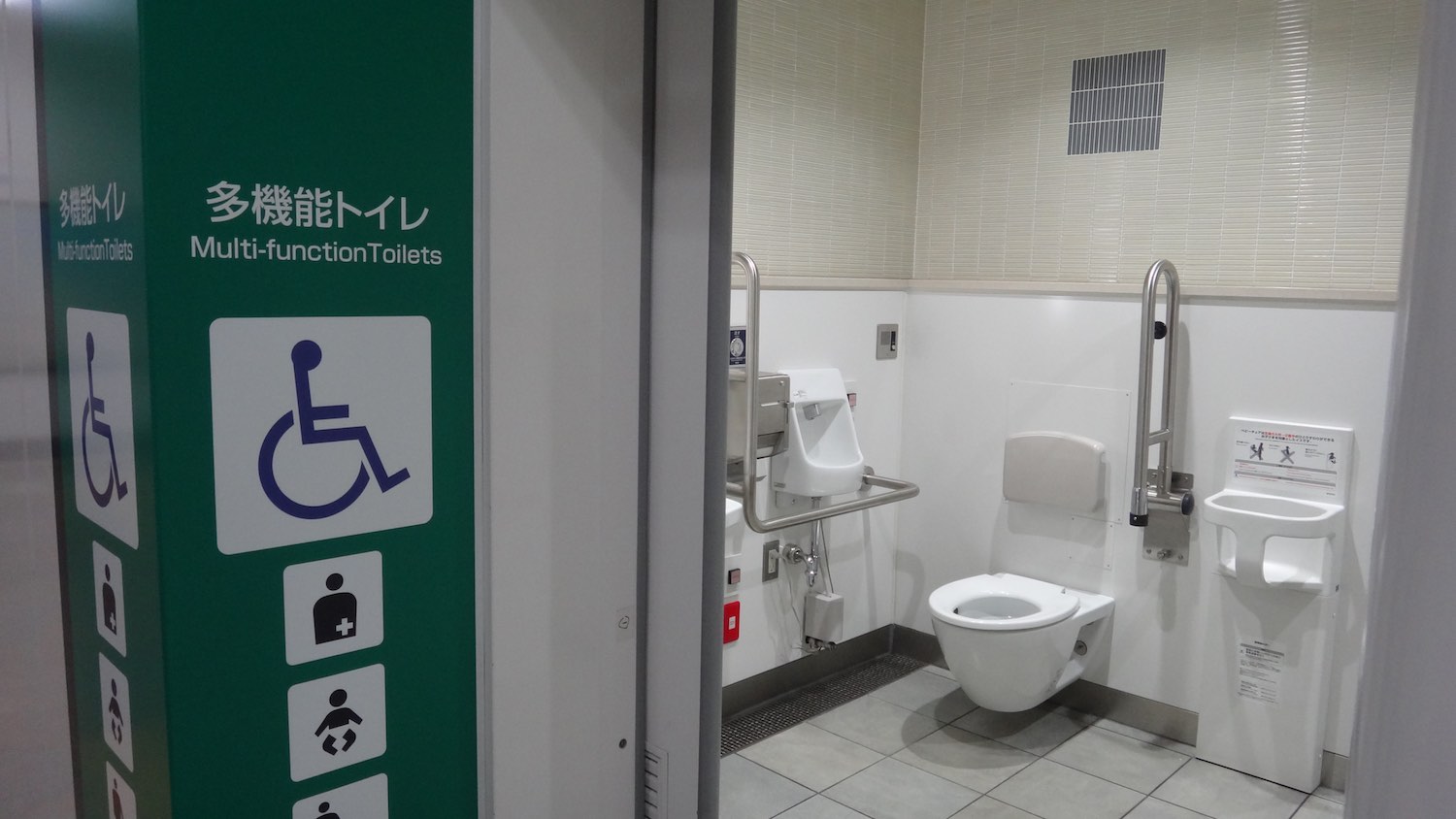 Toilet at Sendagi metro station
Toilet at Sendagi metro station
Toilets
Tokyo and Japan in general has a good number of spacious, accessible toilets. Most train and subway stations have them. Department stores and newer malls all have them.
If you need to find a toilet, here are some useful expressions:
Where is the toilet? トイレはどこですか? *toireto wa doko desu ka? *
Where is the accessible toilet? 多機能トイレはどこですか? taiki-toire wa doko desu ka?
Getting Around
Even though Tokyo is quite complex, even for locals, it has some useful design elements. For example, central areas often have:
- Level pavements, and small ramp access
- Embossed tiles on pavements for people with visual disabilities
- Ubiquitous automatic doors in buildings
- Lifts (especially to small buildings with restaurants on the higher floors)
- Accessible toilets
- Providing traffic sound signals for persons with visual disabilities
- Protip from Onehotprocessor via Reddit: The yellow guiding lines throughout stations often guide you to the lifts too!
The general challenges are
- Complicated and old metro and train stations. Most have lifts, but they’re usually on one end, and you have to navigate through narrow platforms
- Lots of people. Avoid rush hour at all costs (7-9am, 6:30-9pm).
Useful phrases would be:
Excuse me. Where is the lift? すみません、リフトはどこですか? *sumimasen, rifuto wa doko desu ka? *
Thank you! ありがとうございます / ありがとう arigatogozaimasu / arigato
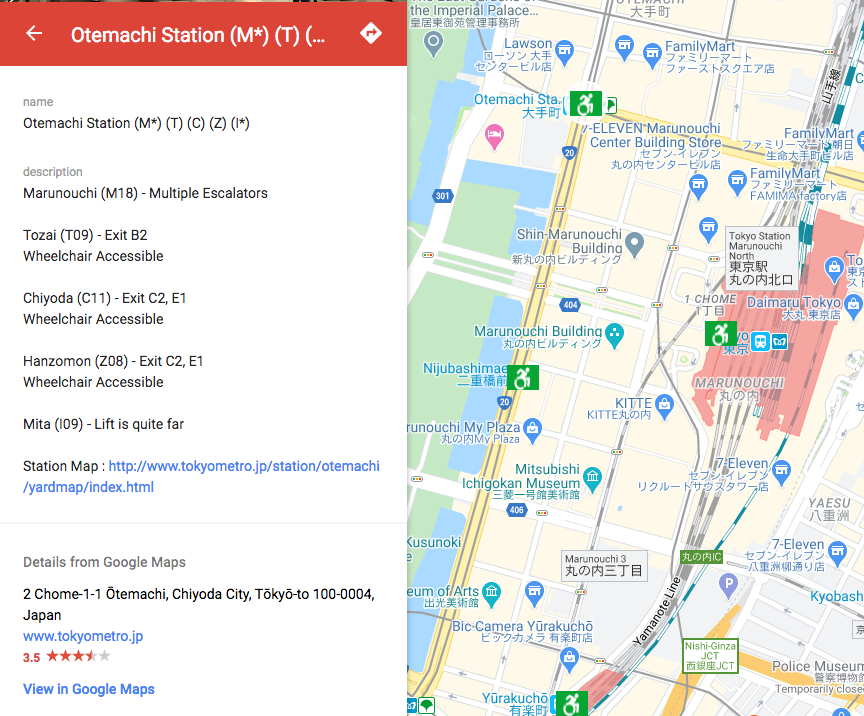 Checking exits on Accessible Tokyo Map.
Checking exits on Accessible Tokyo Map.
Metro Stations and Trains
Note that Tokyo has several train and metro companies. In addition, the trains that come into the Tokyo metropolitan area double up as the metro trains as well. For example, if you are coming in from Haneda Airport, the Keikyu private train line becomes the metro when it reaches the beginning of the Tokyo metro map (click on link to see), but travellers do not necessarily need to get off if the train continues through the city. Don’t worry if you get the wrong ticket: a station attendant can always help you adjust the fare at no extra charge.
Staff at the train stations can assist people with to the train. The major challenge is language. They also normally provide a ramp to get on and off the train as there is a gap. You can ask an attendant at the station, but might save some time if you phone ahead. Below are the numbers for two major train companies with an English service:
- JR Train Phone (English) can arrange help at the station in advance Tel: 03 3423 0111 (Open weekdays 10:00-18:00)
- Tokyu Corporation Train Phone (English) arrange help at stations in advance Tel: 03 3477 0109 (Open weekdays 09:30-17:30)
Buses
Some public buses have low step and wheelchair accessibility. However, the bigger challenge with buses are the local routes and unintuitive stops. I would not recommend taking buses unless you have at least conversation-level Japanese and can read the Kanji station names.
Taxis
Regular taxis can be hailed as long as there is a pull-over spot. A wheelchair accessible taxi needs to be reserved in advance, even for hotels. If you are staying at a hotel, I would suggest you ask the front desk to help you make the reservations. The following companies can provide wheelchair accessible taxis:
- Hinomaru Limousine Tel: 03 5689 0423
- Tokyo Airporter
- Universal Taxi / Jumbo Taxi (Japanese) Tel: 03 3455 3503 (weekdays 10:00-18:00), 03 3482 4511 (weekends 10:00-18:00)
- Hitachi Automotive Transportation Group (Japanese) Tel: 03 5682 1122
Travel information
The following resources are helpful for planning journeys:
- The Accessible Tokyo Map, which can be preloaded onto your phone for you to search your Tokyo Metro and JR Yamanote routes
- Airport Limousine bus accessibility information
- Haneda Airport barrier free information
- Narita Airport information
- Japan’s train station diagrams and maps (not just Tokyo)
- JR East train company accessibility information
- JR East train company station diagrams and maps
- Keisei company train station diagrams and maps (stations such as Oshiage Skytree)
Access Parking
Marked parking spaces are required by law and can be found in most car parks.
Buildings, Restaurants, and Eating Out:
Many independent restaurants, bars and cafes have steps at the entrance. Many higher end restaurants may also have a genkan, an entryway where one takes off one’s shoes before stepping up into the building. Unfortunately, these are mostly inaccessible.
However, the good news is you can find many good restaurants in department stores and inside train stations. For example, the Tokyo Main Station has barrier-free access, and there are restaurants inside that you can choose from. In department stores there are lifts where you can access restaurants in the basement and upper floors. Examples of department stores are Mitsukoshi, Matsuya, Takashimaya, Lumine, Daimaru, and Seibu, which are often right above metro and JR stations such as Tokyo Shinjuku, Ikebukuro, and Shibuya.
Some Sightseeing Areas
Many of the tourist attractions in Tokyo have designated accessibility features. Many of the attractions are also shopping areas, such as Shinjuku, Shibuya, Roppongi, Odaiba and Oshiage Skytree. These stations have accessible exits, which you can see in the Accessible Tokyo Map. The main challenge is navigating through the complex stations and all the people. Be sure to look at station maps and plan your route.
Below are some links of sights to visit:
- Edo Tokyo Museum
- Ghibli Museum (tickets must be purchased minimum 1 month in advance)
- Meiji Shrine (path is wide, but it is gravel!)
- Odaiba **(Gundam Statue, massive shopping complexes futuristic show rooms)
- Roppongi Hills (shopping mall, paid observation tower)
- Tokyo Midtown
- Tokyo Disney Resort Information Centre – Barrier Free Information Tel: 0570 00 8632 / 045 330 5211 (in country)
- Tokyo Metropolitan Building (Shinjuku, for free view of city & sunset)
- Kabukiza (Kabuki Theatre: Accessible seating can be requested in advance +81 3 6745 0888 / 03 6745 0888 (in country)
Happy travels!
For more information, you can also check out the Japan Accessible Association.
You can also check the Tokyo Metro website for barrier free station information, including washrooms.
